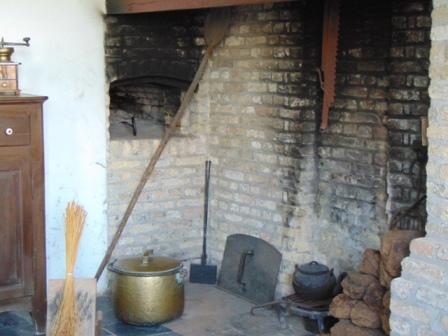For fuel was brushwood (prunings, finger thick branches) collected. Because a lot of loose twigs take huge place and are unstable thigh-thick bundles (fagots) were tightly bound together with a loop of wire. It works easily and quickly, and much force can be exerted. They were piled under cover.
A knotting horse is a tool to tie fagots, to bind small firewood tightly together. The simplest form has two sturdy, thick poles with a strong rope (or chain) connected at the same height (1 / 3rd). Place them briefly apart with the short end and the rope on the ground. Put up and in between there branches. Pull the upper edges crosswise to and over one another, so that the firewood will be compacted and can be bound at 2 or 3 places with rope (wire or twigs). Larger structures (tables ...) with similar leverage functions exist.
After a few weeks baking you knew exactly how many fagots you needed to heat the oven enough for the weekly charge of bread. To get the oven hot enough you need over 1hr of firing.
The heat is accumulated in the bricks and afterwards delivered to the bread. A thicker dome can give more heat.
 If the bread is baked on clay plates (with an iron band around) or in tins, then you just have to rake the ashes to the side. If it was baked on the floor, then first of all the ashes were raked into the extinguisher. No childish little rake, because that takes too long. Then the oven was wiped with a wet mop: the slut. The ashes in the extinguisher are still hot enough for a great barbecue. A pleasant combination.
If the bread is baked on clay plates (with an iron band around) or in tins, then you just have to rake the ashes to the side. If it was baked on the floor, then first of all the ashes were raked into the extinguisher. No childish little rake, because that takes too long. Then the oven was wiped with a wet mop: the slut. The ashes in the extinguisher are still hot enough for a great barbecue. A pleasant combination.
For pizza it is usual to make a fire in the furnace, and let it burn besides the pizza. Those ‘black ovens’ are heated by burning wood inside. Food is cooked in that same chamber, sometimes near a still burning fire (pizza), or after sweeping the ashes out. Besides there were also ‘white ovens’, heated by a separate combustion chamber and it’s flue-gas path. Thus, this oven remained "white", or clean from ash and soot.
 Experience and observation teach you when the oven is ready to use. (A thermometer is also useful You can build a bimetallic thermometer in the (iron) door.) You must stoke long enough: the heat has to enter in the stones, they shall give sufficient heat to bake for 1 to 3 hours after you stopped stoking.
Experience and observation teach you when the oven is ready to use. (A thermometer is also useful You can build a bimetallic thermometer in the (iron) door.) You must stoke long enough: the heat has to enter in the stones, they shall give sufficient heat to bake for 1 to 3 hours after you stopped stoking.
Some tricks that were used to test whether the oven is hot enough :
- spit in the oven, the saliva must evaporate immediately.
- throw some grain in the oven, this should be brown after 2 seconds.
- throwing in a piece of newspaper: this should ignite immediately.
- The vault must be white : by the fire caused soot and creosote deposits make the sky black. The heat burns this coating and it then will become white again.
- For good combustion, only white ash is left over.
- Our brick oven was good if you went with the squeegee across the sky and sparks dismounted.
The outside temperature also plays along, both for heating and cooling and cooking time!
